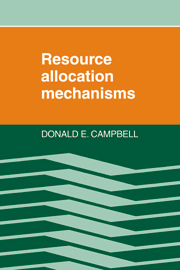Book contents
- Frontmatter
- Contents
- Preface
- Chapter 1 Introduction
- Chapter 2 Performance criteria
- Chapter 3 The Arrow–Debreu world
- Chapter 4 Uncertainty
- Chapter 5 Incentive compatibility
- Chapter 6 Existence of a competitive equilibrium
- Chapter 7 Welfare properties of the Walrasian mechanism
- Appendix 1 Elements of consumer choice
- Appendix 2 The Edgeworth exchange economy
- Appendix 3 Proof of the Shafer–Sonnenschein theorem
- References
- Author index
- Subject index
Appendix 2 - The Edgeworth exchange economy
Published online by Cambridge University Press: 05 June 2012
- Frontmatter
- Contents
- Preface
- Chapter 1 Introduction
- Chapter 2 Performance criteria
- Chapter 3 The Arrow–Debreu world
- Chapter 4 Uncertainty
- Chapter 5 Incentive compatibility
- Chapter 6 Existence of a competitive equilibrium
- Chapter 7 Welfare properties of the Walrasian mechanism
- Appendix 1 Elements of consumer choice
- Appendix 2 The Edgeworth exchange economy
- Appendix 3 Proof of the Shafer–Sonnenschein theorem
- References
- Author index
- Subject index
Summary
The two-person, two-commodity exchange economy provides a remarkable amount of insight into resource allocation in general and the market mechanism in particular. Accordingly, assume that production has already taken place and that all net output is owned by households. Each household wishes to exchange goods that it holds in abundance for the goods it lacks.
There are two commodities and two consumers. An allocation x = (x1, x2) assigns a nonnegative commodity bundle xi = (xi1, xi2) to each individual i = 1, 2. Individual i's preference relation is assumed to be strongly monotonic and strictly convex and representable by a continuous and differentiate utility function ui(xi) with positive marginal utilities everywhere (i= 1, 2). These assumptions will be implicit in the hypotheses of both of the theorems to follow.
Household i (i = 1, 2) has an endowment vector wi = (wi2, wi2), and w1 + w2 specifies the total stock of each of the two goods available to the community. Allocation,x is feasible if x ≥ 0 and x1 + x2 ≥ w1 + w2. An allocation x ≥ 0 is balanced if x1 + x2 = w1 + w2. Allocation x is Pareto optimal if it is feasible and there is no feasible allocation y such that u1(y1) > u1(x1) and u2(y2) > u2(x2).
- Type
- Chapter
- Information
- Resource Allocation Mechanisms , pp. 166 - 169Publisher: Cambridge University PressPrint publication year: 1987



